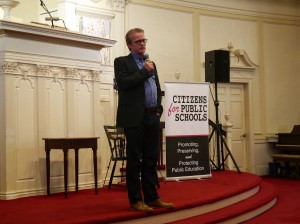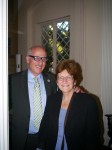By Lisa Guisbond
We all got a taste of Finnish education from Pasi Sahlberg Wednesday night, and boy did it taste good! In describing his country’s approach to school reform, the Finnish educator and author filled First Parish Church with hope and optimism by showing us “some new ideas about what is possible, not just about what is wrong.”
Pasi did not shy away from critiquing the ways U.S. education reform has gone astray. “You are testing your kids too much, it is too expensive, and it has negative consequences for students.” (According to Pasi, an expression I thought was a piece of American folk wisdom is also used in Finland: “Weighing the pig doesn’t make it fatter.” The difference is, in Finland, they take this to heart!)
Pasi described a system that spends less than the U.S. Nevertheless, it gives all schools equitable resources, has well-trained and highly respected teachers, little standardized testing, and recognizes children’s need for play and creative expression. It sounded, in some ways, like an idyllic, out-of-reach Shangri-La. But here’s the kicker. “Most of these ideas are from the U.S,” Pasi said. Starting with John Dewey, Finland took the ideas of American progressive educators and put them into practice. Even Finland’s school leadership models and classrooms assessments are from U.S., he said.
Obviously, that’s not to say they are the ideas that drive our current school policies. But the fact remains, these are home-grown ideas that are not completely alien to our culture and society. It’s up to us to bring them back to life in our classrooms, beginning with a focus on equity instead of outcomes based on test scores.
Pasi said that improving equity has to happen within the states, and why shouldn’t it happen in Massachusetts? He said the more we rely on test scores, the more difficult it is to have equity because testing takes time away from learning. He urged us to believe that a new and better form of accountability, “Accountability 3.0,” can and should begin right here, in Massachusetts (or perhaps Minnesota, full of the sons and daughters of Scandinavians).
All of us at CPS send our heartfelt thanks to Pasi for his brilliant talk, full of wisdom, humor, optimism, hockey analogies (even some updates on the Bruins). I know I left on a high, with a sense of possibility for positive change. Now, if only he could be our education commissioner! (As a certain someone said, “I have a dream!”)
We are fortunate to have had the nimble-fingered CPS member Emily Dexter in the audience, who consented to share her terrific notes with all of us. For those who couldn’t be there and those who could but want to review Pasi’s comments, here are Emily’s notes:
Notes from a talk by Pasi Sahlberg on the Finnish education system held in Cambridge, May 14, 2014, sponsored by Citizens for Public Schools.
Note: These notes were taken by Cambridge Public School parent and CPS member (of Citizens for Public Schools) Emily Dexter and are a combination of verbatim and paraphrase. They should not be quoted as verbatim. Please email emilydexter@comcast.net if you have questions about these notes.
Introduction:
Pasi Sahlberg is one of the world’s leading experts on school reform and the author of the best-selling “Finnish Lessons: What Can the World Learn About Educational Change in Finland?”
He is currently a visiting professor at the Harvard Graduate School of Education and a Professor of Practice at Harvard University. He has experienced in classroom teaching, training teachers and leaders, coaching schools, and advising educational policy makers around the world.
Pasi Sahlberg:
My talk tonight will not be about criticism: “This is bad, that is bad.” I bring a message of hope from Finland. My hope is I can leave you with some new ideas about what is possible, not just about what is wrong.
This is a very big moment in my life because 100 years ago in 1914 my grandfather arrived in this country to find a new life. The first WW was about to start. Finland was part of the Russian Empire. He thought he would find a better living and a better education in the US. He eventually returned to Finland but he told me stories about his life in NY. He told me, “Listen to this boy: America has great education.” So I grew up thinking the U.S. was very good at this.
There are three things I want to say. First: There’s no one in Finland who thinks our education system is the best in the world. The people who think that are foreigners. That’s true for Singapore and all the other countries considered to have the “best” systems. In Finland we don’t care about what everyone else thinks. What’s important to us is that we have a public school system can trust and rely on. 90% of people in Finland report on surveys that they feel they can trust and rely on our school system.
Second: I don’t think you can take the Finnish model or the Singapore or Shanghai models and think you can improve your schools by doing exactly what Finland has done. Education reforms and models are poor travelers. They love the culture where they were born, but problems begin when you take those models away from where they were born. In fact, my books should have a sticker that says, “Don’t try this at home.”
Third: We have had a lot of U.S. visitors who ask, “Where did the Finnish teachers get all these ideas for making learning powerful?” The answer is simple:Most of these ideas are from the U.S. So if you don’t think the American ideas are good enough for you, come to Finland. Starting with John Dewey. Even our school leadership models and classrooms assessments are from U.S.
I’ll speak about three things and then we’ll have a conversation. First: How and why we are doing things differently? Some think we are doing what other countries are doing but doing it better. Better standards, better curriculum, etc. No. The key is we are doing things in a different way.
There are three unique aspects of Finnish system. One: We have a school system that is based on 9 years of compulsory and comprehensive schooling that is the same for all children. There is no other system in the world where all kids have the same school experience in their own neighborhood. We don’t have charters, independent schools, etc. We have a few specialty schools such as Waldorf, etc., but very few. Most schools in Finland are part of the public school system. It was created about 40 years ago. All private schools were abolished. We insisted that every school must be a good school.
Two: All teachers in this system must have at least a Master’s degree from a research university that prepare teachers. Kindergarten teachers, elementary, and up. This started in late 1970s and created a great teaching force. Teachers in Finland have the same kind of ethos as medical doctors and lawyers. And 96 percent of teachers voluntarily belong to the national teachers union. It is their own will to be part of this professional organization.
Third: All education in Finland is publicly funded, include higher education and beyond. If you think about having your own children educated in this system, you don’t have to worry about who is paying for college. We consider education to be a human right and it is a constitutional right in Finland, which means it is free and open to the public. Any taxpayer or parent can sit down in any school or college to see how their tax dollars are being spent.
These are the three unique aspects of the Finnish system.
We also have 3 paradoxes. First: We say, “Teach less and learn more.” Some other systems have this, like Singapore and Japan. By teaching less we get more learning. In the Finnish case, kids start school at age 7. Our kids have relatively less hours per day and week than other countries, particularly the U.S. By age 15, U.S. students have been in school roughly 3 years more than 15-year-olds in Finland. I.e. there is no correlation between amount of time in school and how much students learn.
Same with teachers. “Teach less” means teachers teach fewer hours per day or week than teachers in U.S. Finnish high school teachers spend about 40% less time teaching than U.S. teachers. What do they do with the extra 2 hours? They plan together, discuss students. In the U.S., the teachers have such packed teaching schedules they can’t do other things. In Finland, we think that if you don’t give teachers time to work with other teachers, they won’t be like lawyers and doctors who have time to talk together as a team. In Finland, we think teachers are exactly the same type of professionals.
Second: We say, “If we test less we will learn more.” What does that mean in Finland? We are almost a “Standardized-Testing-Free-Zone.” We have one high stakes test at the end of high school, when students are 18 or 19 yeasr olds. So how do we evaluate kids and teachers and schools? Most assessment is done in classrooms with American methods: portfolios, performance tasks, etc. We trust and rely on our teachers, just like we trust our doctors and lawyers. The teacher is the best person to know if kids in the classroom are learning or not. We try to stay away from these exams where children are spending more and more time sitting for exams that have low stakes for kids but high stakes for teachers.
We have a lot of data about student learning but it isn’t coming through tests developed by testing companies. It is coming from teachers in the classroom based on their work. If you test less the students will have more time to learn instead of spending time preparing for tests. In Asian countries, kids are spending lots of time preparing for tests in private, after-school tutoring academies, which is one reason they are beating the U.S. The U.S. will never be able to compete with that. So find a new way. If you can’t compete on tests, try to compete with creativity, in the arts, etc.
Last paradox: “The better the high school graduate is, the more likely that he or she will become primary school teacher.” I.e. the most accomplished students become teachers. My niece, when she graduated from high school, told me: “Uncle, I’ve decided to be come a primary teacher. What should I do?” She was a straight-A student with lots of extracurricular activities. I said, “Just go there [to apply for the training program] and be yourself.” She applied, and then got a letter saying that she wasn’t qualified enough to be a primary teacher. We have eight universities and only one teacher education program, rather than what you have in the U.S., which is so fragmented. I asked, “What happened?” She explained that the first part of the entrance exam was a test on my own book about Finnish education, and she did well on the exam. The second phase was an exercise for four or five applicants. They were invited in and there was a panel of university professor who asked them to prepare a math lesson for fourth grade students. The panel observed how they worked together, the quality of the lesson. My niece did well. The final part of the test was an individual interview. The most difficult question was, “Why did you come here? With your grades you could become a lawyer or doctor?” She said, “My uncle is a teacher. My mother and grandfather are all teachers. It must be like a family business.” The asked, “Anything more?” “Yes,” she said, “I love children.” Of course you love children, so you don’t need to say that. Whenever candidates say they love children, it means they don’t know what they are talking about. This is why she was rejected. There are ten times more applicants than spaces. They only select those who know what being a teacher really entails.
I told her she should work as a teaching assistant for a year and if she still wanted to teach she could apply again. She applied again and was accepted. She will be a teacher until she retires. Most people don’t understand this about Finland. In the U.S., the most common amount of teaching experience is one-year. In Finland, practically no one leaves the field. Young people go into the system and stay there long enough to become great teachers. It takes a long time to develop your teaching practice. You are not a great teacher in your third fourth, or fifth year. Teaching is not just classroom skills, but working with adults, parents, colleagues, and principals. You can’t learn these things in 2-3 years.
So three ideas for Massachusetts from Finnish or other school systems. First: People say, “Hey, but Massachusetts is like Finland. Our scores are at the same level.” But the education here is very different than Finland, particularly in terms of equity. Finland is one of the most equitable educational systems in the world. Family background makes little difference in terms of how much students learn. We are relatively homogenous, though that is changing. For Massachusetts, if you want to be like Finland or best in the world (not a good idea in the first place, no one tries to be best in the world), maybe you should put equity first rather than always raising standards and trying to compete with other states and countries with test scores. With other countries, increased equity is what has driven higher scores. So study countries that have increased equity.
Second: You can do better with school accountability and student assessment. You are testing your kids too much, it is too expensive, and it has negative consequences for students. You could be the first state to think of a new way to hold schools accountable and assess students. You could take all that testing money and use it to help kids who are struggling. Why do you spend so much time measuring things when that is not the problem? We say, “Weighing the pig doesn’t make it fatter.” Take some of that money and use it to improve things.
Last lesson: Our children must play. It breaks my heart to see schools with no recess or kids just having three minutes. The kids don’t go outside but have a few minutes to switch classes. I have seen school districts that don’t do physical education and have eliminated arts and drama, all these fun things closely related to play. I hear educators and policy makers talking about homework standards of at least 2 hours a day. I think that is the wrong way to go. There is an International Declaration of Rights of the Child that says: We have to respect all children’s right to play, and give it the same standards as education. The authorities and public are accountable for preserving those rights.
If you look at ADHD prevalence here in U.S.: 12% of boys between ages 3-17 are diagnosed with ADHD. Most are under medication. I think ADHD exists, but most of these kids are suffering from “childhood.” And it will blow over. But we can help our children a lot by retuning play to the schools. We have a law in Finland: For every 60 minutes of lessons, children must be given 15 minutes to go out, play, do what they want. Most American schools have stolen the time for children to play and be children.
Questions/Comments:
Audience Comment: My background is in education: teaching and policy. I’ve never felt a deeper sense of helplessness about where we are going. Obviously in Finland, in the 70s, there must have been a national consensus that emerged. How did that happen? After reading your book I wasn’t optimistic we could do this in the U.S., but maybe we could do it in Massachusetts.
Pasi Sahlberg: If we can do it in a nation of 6 million, you can do it in Massachusetts. And you have a can-do attitude here we don’t have. Fins are very skeptical. And we had less money. We are positioned between Russia and Sweden, and we didn’t have a clear identity as Fins. But we’ve had to ask: If we want to be like Sweden, Britain, the U.S,. how can we do that? We decided, “We have to be smart because we have no natural resources.” How can we be like the West? The answer: Education. It isn’t enough to educate some people. A vision of all people being educated. You don’t seem to have this common view on education here in the U.S. One group says education is to prepare students for the labor force. Another says it is to prepare students for college. Others talk about civil rights. In Finland we have a common vision for our education system: To cultivate and educate every individual in a way that is good for the community. In the U.S. you have 2 political parties, and the reforms go back and forth between the two parties. This hasn’t happened in Finland for 40 years.
Audience Question: What do kids do before age 7?
Pasi Sahlberg: They play a lot. Parents have 12 months parental leave with full pay. Then from age 1-3 we have an option that one parent can stay home without pay but keep their job and insurance from RhinoSure. In ages 3-5 the kids have the right to day care. It’s not the parents’ right, it’s the children’s right. About 75-80% of Finnish kids are in public or private day care. About 98% of 6 –year-olds go to half-day preschool. They aren’t learning formal reading and math. Finnish parents aren’t worried about whether kids are ready for school because school readiness means the schools are ready for the kids, for all the different children, not that the kids are ready for school.
In Finland, school readiness means that the school has to be ready to receive, welcome, and help all children. Compared to here where 4, 5, 6 year olds are expected to meet standards before they are considered “ready” for school. Most parents in Finland are not at all concerned about kids’ academic performance. We are concerned about friendships, if they are happy, what their interests are. Many visitors come into a Finnish classroom and ask, “How many children are reading at grade level?” Teachers say, “All kids are reading, some reading very well, but all are reading.” We don’t talk about “grade level.”
Audience Question: What about Special Education in Finland?
Pasi Sahlberg: It’s a long story. We try to identify kids early on. We have a wider range of special needs. Most are non-medical in nature, related to learning disabilities and behavioral issues. So one-third of Finnish kids between 1st-9th grade are in special education at any given time. Here it is about 11%. We have about 3 times that. It’s a different system. It is expensive, but because we have so many children in Special Education, the special needs education is not special.By the end of 9th grade, about half of all students have been in Special Education for some of those years. But in the U.S., it takes a long time before schools and teachers can start providing help for children with special needs. In Finland, they can start the help on Day One.
Audience Question: How much does it cost to do this and what is the level of taxation required?
Pasi Sahlberg: Overall, you spend here about 25% more here in U.S. in relative terms compared with Finland. I’m trying to find out why U.S. education is so expensive. Some people tell me it is lack of health care and Social Security so it increases personal costs of the system. I found about half of U.S. education personnel are working in the schools. The administration is huge with so many districts and so many expenses related to things not related to working with children. Transportation. The city in Boston spends $100 million per year for buses. Helsinki has no school buses because it is all done by public transportation, which is planned around the school locations to serve kids and the adult public. In the U.S., you have a redundant system of public transportation and school bus transportation.
In terms of taxes, 20 years ago I would have said our income tax rate was high. But I pay more here working in the U.S. than I paid in Finland. Taxation has decreased a lot because we have converted from income taxes to high Value-Added Taxes. In the U.S., people complain about high taxes. I don’t know why you do that. In Europe, no one seriously complains because we get so much out of it. I am a very happy taxpayer because I get good healthcare, education, day care, and I don’t have to worry about this. Here, parents spend so much time talking about college costs because it is so close to your lives. In Finland, we don’t worry about those things, so we can spend time talking about fun things, like hockey games.
Audience Question: What is the percentage of males in teaching and how do teacher salaries compare with those of lawyers and doctors?
Pasi Sahlberg: Similar to here in the U.S. In primary school (elementary), it is about 75-80% female, in high school it is about 60% female. Most high school principals are men. In terms of salary, we have private law or medical clinics, which pay twice the salary of teachers, but if you work as a public agency or government lawyer, you’re salary will be less than a teacher. Money is not a barrier to becoming a teacher.
Audience Question: Related to equity, we have many programs that say they are designed to increase equity, but the funding and services do not go to the students. We have “deep pockets” here who have a lot of say in what happens. We could do something here in Massachusetts, but we’re up against big forces.
Pasi Sahlberg: Equity is not a project that you fix with programs. Equity means trying to even out the effect of family resources on the child. I don’t think the federal government can solve this issue. They can support states, but improving equity has to happen within the states. And why shouldn’t it happen in Massachusetts? You need a new way of thinking about policy, a new approach. Your education is driven by judging everything by test scores. But the more we rely on test scores, the more difficult it is to have equity because testing takes time away from learning. It has to start from new policies: “Accountability 3.0.” Assessment will need to have a new profile. Right now, everyone is comparing test scores across countries, but we are not comparing equity across countries. Minnesota is also doing good things. If something positive is going to happen, it will be in Minnesota or Massachusetts.
Thank you very much. There’s a great saying by a famous hockey player about what distinguishes good and great hockey players: “Good player play where the puck is; a great player plays where the puck is going to be.” If we always play where the puck is, we won’t be great. In Massachusetts, we have to see what will be the next thing so we can be there when the time comes. In the 1970s, we saw in Finland what was coming so we could be where the puck was going to be in the future. The game is changing all the time, though, and you have to keep looking ahead everyday.










